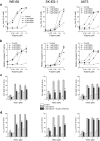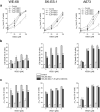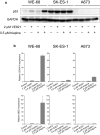Synergistic anticancer activity of combined ATR and ribonucleotide reductase inhibition in Ewing's sarcoma cells
- PMID: 37097390
- PMCID: PMC10374484
- DOI: 10.1007/s00432-023-04804-0
Synergistic anticancer activity of combined ATR and ribonucleotide reductase inhibition in Ewing's sarcoma cells
Abstract
Purpose: Ewing's sarcoma is a highly malignant childhood tumour whose outcome has hardly changed over the past two decades despite numerous attempts at chemotherapy intensification. It is therefore essential to identify new treatment options. The present study was conducted to explore the effectiveness of combined inhibition of two promising targets, ATR and ribonucleotide reductase (RNR), in Ewing's sarcoma cells.
Methods: Effects of the ATR inhibitor VE821 in combination with the RNR inhibitors triapine and didox were assessed in three Ewing's sarcoma cell lines with different TP53 status (WE-68, SK-ES-1, A673) by flow cytometric analysis of cell death, mitochondrial depolarisation and cell cycle distribution as well as by caspase 3/7 activity determination, by immunoblotting and by real-time RT-PCR. Interactions between inhibitors were evaluated by combination index analysis.
Results: Single ATR or RNR inhibitor treatment produced small to moderate effects, while their combined treatment produced strong synergistic ones. ATR and RNR inhibitors elicited synergistic cell death and cooperated in inducing mitochondrial depolarisation, caspase 3/7 activity and DNA fragmentation, evidencing an apoptotic form of cell death. All effects were independent of functional p53. In addition, VE821 in combination with triapine increased p53 level and induced p53 target gene expression (CDKN1A, BBC3) in p53 wild-type Ewing's sarcoma cells.
Conclusion: Our study reveals that combined targeting of ATR and RNR was effective against Ewing's sarcoma in vitro and thus rationalises an in vivo exploration into the potential of combining ATR and RNR inhibitors as a new strategy for the treatment of this challenging disease.
Keywords: ATR; Didox; Ewing’s sarcoma; Ribonucleotide reductase; Triapine; VE821.
© 2023. The Author(s).
Conflict of interest statement
The authors declare that they have no conflict of interest.
Figures





Similar articles
-
Depressing time: Waiting, melancholia, and the psychoanalytic practice of care.In: Kirtsoglou E, Simpson B, editors. The Time of Anthropology: Studies of Contemporary Chronopolitics. Abingdon: Routledge; 2020. Chapter 5. In: Kirtsoglou E, Simpson B, editors. The Time of Anthropology: Studies of Contemporary Chronopolitics. Abingdon: Routledge; 2020. Chapter 5. PMID: 36137063 Free Books & Documents. Review.
-
Comparison of Two Modern Survival Prediction Tools, SORG-MLA and METSSS, in Patients With Symptomatic Long-bone Metastases Who Underwent Local Treatment With Surgery Followed by Radiotherapy and With Radiotherapy Alone.Clin Orthop Relat Res. 2024 Dec 1;482(12):2193-2208. doi: 10.1097/CORR.0000000000003185. Epub 2024 Jul 23. Clin Orthop Relat Res. 2024. PMID: 39051924
-
Genedrive kit for detecting single nucleotide polymorphism m.1555A>G in neonates and their mothers: a systematic review and cost-effectiveness analysis.Health Technol Assess. 2024 Oct;28(75):1-75. doi: 10.3310/TGAC4201. Health Technol Assess. 2024. PMID: 39487741 Free PMC article.
-
A multicomponent psychosocial intervention to reduce substance use by adolescents involved in the criminal justice system: the RISKIT-CJS RCT.Public Health Res (Southampt). 2023 Mar;11(3):1-77. doi: 10.3310/FKPY6814. Public Health Res (Southampt). 2023. PMID: 37254608
-
Trends in Surgical and Nonsurgical Aesthetic Procedures: A 14-Year Analysis of the International Society of Aesthetic Plastic Surgery-ISAPS.Aesthetic Plast Surg. 2024 Oct;48(20):4217-4227. doi: 10.1007/s00266-024-04260-2. Epub 2024 Aug 5. Aesthetic Plast Surg. 2024. PMID: 39103642 Review.
Cited by
-
Enhancing Standard of Care Chemotherapy Efficacy Using DNA-Dependent Protein Kinase (DNA-PK) Inhibition in Preclinical Models of Ewing Sarcoma.Mol Cancer Ther. 2024 Aug 1;23(8):1109-1123. doi: 10.1158/1535-7163.MCT-23-0641. Mol Cancer Ther. 2024. PMID: 38657228
-
Stemness and Cell Cycle Regulators and Their Modulation by Retinoic Acid in Ewing Sarcoma.Curr Issues Mol Biol. 2024 Apr 26;46(5):3990-4003. doi: 10.3390/cimb46050246. Curr Issues Mol Biol. 2024. PMID: 38785514 Free PMC article.
-
Therapeutic Targeting of DNA Repair Pathways in Pediatric Extracranial Solid Tumors: Current State and Implications for Immunotherapy.Cancers (Basel). 2024 Apr 25;16(9):1648. doi: 10.3390/cancers16091648. Cancers (Basel). 2024. PMID: 38730598 Free PMC article. Review.
-
Synergistic induction of apoptosis in liver cancer cells: exploring the combined potential of doxorubicin and XL-888.Med Oncol. 2023 Oct 4;40(11):318. doi: 10.1007/s12032-023-02181-9. Med Oncol. 2023. PMID: 37794195
References
-
- Bailey K, Cost C, Davis I, Glade-Bender J, Grohar P, Houghton P, Isakoff M, Stewart E, Laack N, Yustein J, Reed D, Janeway K, Gorlick R, Lessnick S, DuBois S, Hingorani P. Emerging novel agents for patients with advanced Ewing sarcoma: a report from the Children's Oncology Group (COG) new agents for Ewing sarcoma task force. F1000Res. 2019;8:493. doi: 10.12688/f1000research.18139.1. - DOI - PMC - PubMed
-
- Bartek J, Bartkova J, Vojtesek B, Staskova Z, Lukas J, Rejthar A, Kovarik J, Midgley CA, Gannon JV, Lane DP. Aberrant expression of the p53-oncoprotein is a common feature of a wide spectrum of human malignancies. Oncogene. 1991;6:1699–1703. - PubMed
MeSH terms
Substances
LinkOut - more resources
Full Text Sources
Medical
Research Materials
Miscellaneous

